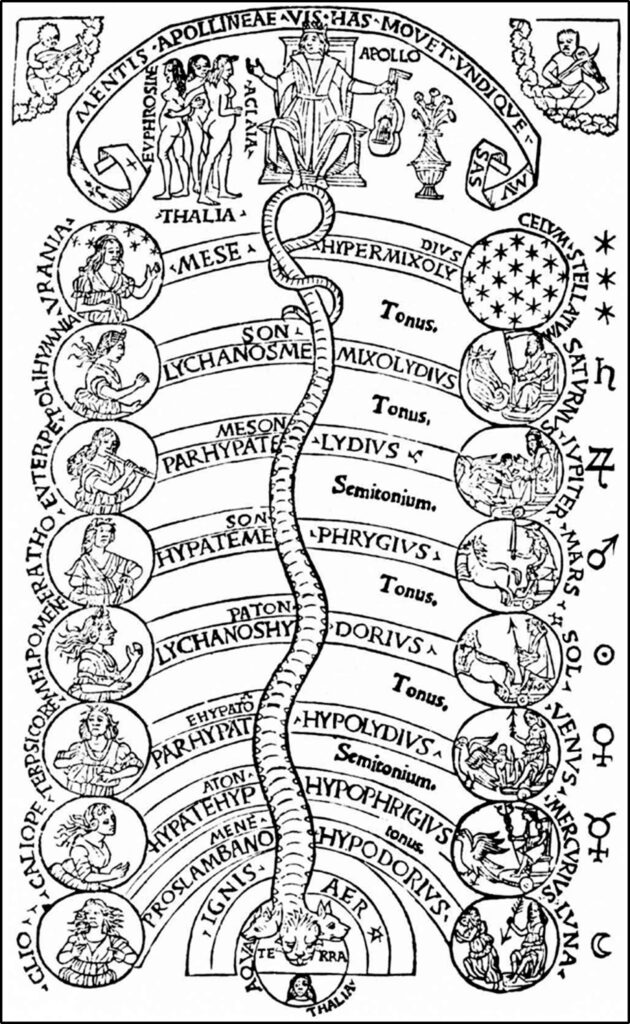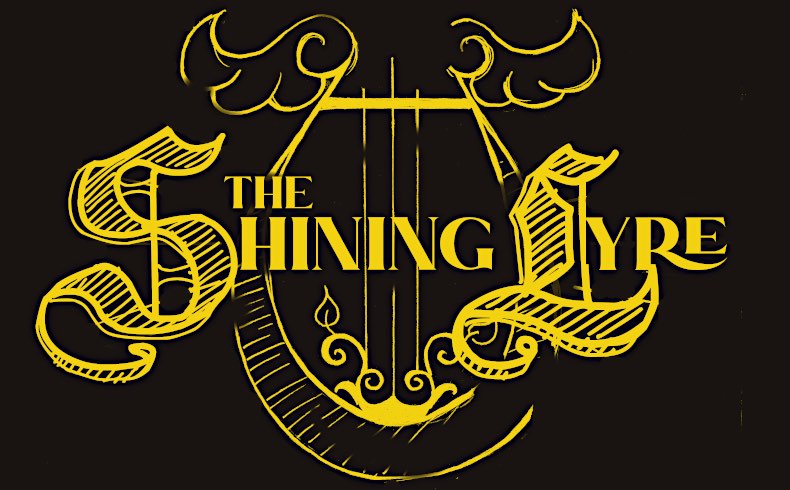Guest author Cory C.Childs of The Shining Lyre discusses the music of the spheres.
In 1496, the Italian music theorist and composer Franchinus Gaffurius released a monumental musical treatise titled “Practica Musicae,” which includes the following image:

Here, we’re presented with a brilliant blend of Ancient Greek and Middle Age music theory with esoteric and mythological concepts that have ubiquitously persisted across time and space. The ten celestial spheres championed by Plato begin at the bottom, with the terrestrial spheres of the elements leading up to the sphere of the mind, crowned with the text “the force of the creative mind moves these Muses on every side.” On the left, the Muses have been bound to the scale degrees of Ancient Greek music theory, while on the right, the planets have been bound to the Gregorian musical modes, themselves derived from the Ancient Greek τόνοι (tonoi) of the Peripatetic Aristoxenus.
By counting the alternating terms of tonus (a whole tone, or the interval of two steps, such as C to D) and semitonium (a semitone, or the interval of one step, such as C to Db) upward from each planet, we’re given a distinct series of intervals for each. In these modes of what we now call the diatonic scale, the character of each planet, derived from mythology and esoteric correspondences, has been expertly and knowledgeably synthesized by Gaffurius in a way that allows the magician to invoke the planet’s nature.
Before we look at each of these planets and their modes in turn, a note on terminology for the musical layman. In the western musical tradition, music is typically in a key, which consists of three parts: first, a tonic, which is the central pitch that all the others of the key orbit around, second, a scale, which is a series of intervals that fit inside the span of an octave, and third, a mode, which is when a certain degree of a scale is treated as a tonic. The diatonic scale has seven scale degrees, and thus seven possible modes.
The first mode of the diatonic scale, Aeolian (the modern equivalent of Hypodorian), is bound to the Moon and can be heard by playing all of the white keys on a piano with A as the tonic. It waxes and wanes with the enchanted inspiration of a mist-veiled glade and the plaintive melancholy of cold, quiet Night.
The second mode, Locrian (Hypophrygian), is bound to Mercury and can be heard by playing all of the white keys with B as the tonic. It craftily puzzles with ingenuitive eccentricity while still evoking the ominous mystery befitting a psychopomp.
The third mode, Ionian (Hypolydian), is bound to Venus and can be heard by playing all of the white keys with C as the tonic. It gently embraces with a sincere beauty that warms the heart and unites with pleasure.
The fourth mode, Dorian, is bound to the Sun and can be heard by playing all of the white keys with D as the tonic. It confidently rules with nobility and gloriously bestows vitality with the illuminating light of brilliant Day.
The fifth mode, Phrygian, is bound to Mars and can be heard by playing all of the white keys with E as the tonic. It aggressively provokes the impulsive strength and passionate ambition that wildly rises to war.
The sixth mode, Lydian, is bound to Jupiter and can be heard by playing all of the white keys with F as the tonic. It sweetly heals with the joy of good fortune that brings about flowing prosperity.
The seventh mode, Mixolydian, is bound to Saturn and can be heard by playing all of the white keys with G as the tonic. It reminds with rustic tranquility the dedicated time required for the fruits of a harvest.
Words only take us so far when it comes to music, however, and I’ve no doubt that your ear will quickly acknowledge and celebrate the efficacious reality of these correspondences. I often invoke all associated with these planets by improvising in their respective mode, but the less musically inclined might prefer to play or sing the mode instead. However one goes about it, the ways in which these modes can aid ritual activity are ultimately limited only by one’s imagination.
The Shining Lyre is an esoteric arts and resources collective owned and operated by Aster Grim and Cory C. Childs. In addition to providing blogs rich with everything involved with myth and magic, they use the arts of phainomancy (the magic of images) and phonomancy (the magic of sounds) to create custom works that range from celebrations of people to material for aiding in ritual activity.
Click here for more tracks written to express the planetary virtues of specific pentacles.
This post was originally a Practical Occult newsletter dated January 19th, 2022 and written by guest author Cory Childs.
